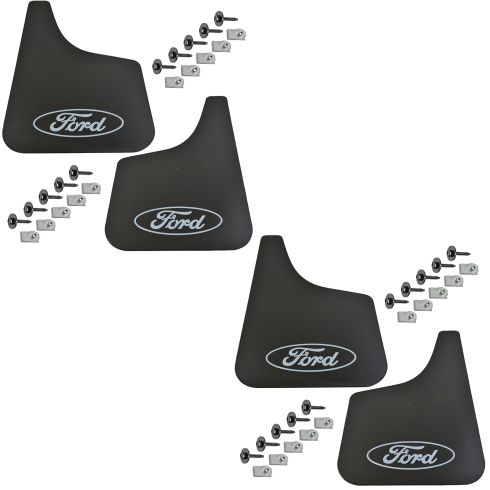FDBMK00064-Ford Mud Flap 4 Piece Set Ford OEM FDBMK00064

Replaces
1990 Ford F350 Truck Mud Flap 4 Piece Set Ford OEM FDBMK00064

Product Reviews
Loading reviews
4.67/ 5.0
3
3 reviews
Just what I was looking for.
April 26, 2020
These mud flaps are just what I was looking for, and they were easy to install.
Excellent service great product
June 28, 2020
We are very pleased with the service we received as well as the quality of the product we received. Thank you for the added video fully detailing the installation of our purchase. Excellent!
August 4, 2022
Love the size easy to install
Customer Q&A
Can I buy the hardware ?
July 13, 2021
10
We do not offer the hardware separately.
July 14, 2021
T I
Will these fit a 1995 Ford F250 7.3 diesel?
August 5, 2021
10
Yes, this part will fit your vehicle.
August 5, 2021
Jessica D
Will these fit with factory step boards f150 super crew 4x4 xlt ?
September 14, 2021
10
These will not fit F150 with running boards from 2004-2009.
September 15, 2021
M N
Will these fit a 2013 F150 FX4 OFF ROAD?
December 20, 2021
10
Very nice! Has held up really well.
December 20, 2021
P F
10
Yes, this part will fit your vehicle.
December 20, 2021
Jessica D
I have 2008 ford e250
This will fit ??
June 3, 2022
10
Yes, this part will fit your vehicle.
June 3, 2022
Cristina P
Will these fit a 2014 F150 with wheel well flares?
August 15, 2022
10
Yes, this part will fit your vehicle.
August 15, 2022
Emma F
Will these fit a 2000 ford ranger xlt 4x4 with flares?
September 9, 2022
10
No, these will not fit your vehicle. We do carry one set for the 2000 Ford Ranger and it is correct6 for models without the wheel lip moldings. The part number is F87Z-16A550-CAA.
September 9, 2022
Andra M
I doubt that I have any of the hardware. What is needed? Can I get it at a hardware store?
December 13, 2022
10
New hardware is not included with this item. You may be able to reuse your original hardware if it is in good condition. If not you can certainly purchase from a local hardware store.
December 15, 2022
Emma F
Will these fit a 2010 F150?
December 19, 2022
10
Yes, this part will fit your vehicle.
December 20, 2022
Ricale A
Will they fit with front fender flair?
March 6, 2024
10
Our parts are exact replacements for your vehicle's OEM parts. As long as your vehicle specifications match up with our listing, these parts will directly fit and function like the originals.
March 7, 2024
Jean O
Ford is a registered trademark of Ford Motor Company. 1A Auto is not affiliated with or sponsored by Ford or Ford Motor Company.
See all trademarks.










